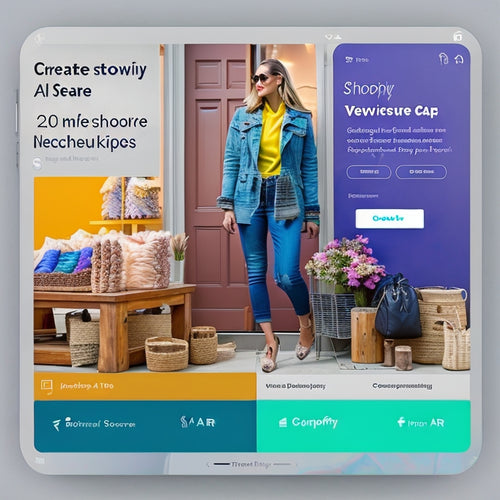
What Digital Ecommerce Integration Methods Work Best?
Share
When constructing a digital online marketplace environment, you need to select the appropriate integration approach. API-based integration offers smooth data exchange, while microservices architecture boosts flexibility and scalability. IPaaS links diverse applications, streamlines processes, and minimizes manual errors. Cloud-based integration platforms provide expandable infrastructure, and point-to-point integration solutions tailor connections to specific business requirements. Explore hybrid integration methodologies for a strategic response to the complexities of online commerce. To guarantee a cohesive customer experience, effective operations, and scalable expansion, you'll want to delve into each approach thoroughly - and uncover how they can be combined to craft a customized integration strategy that propels your business forward.
Key Takeaways
• API-based integration methods ensure seamless data exchange, data security, and access controls for digital ecommerce platforms.
• Microservices architecture approach offers flexibility, scalability, and innovation for ecommerce businesses with decoupled services.
• IPaaS enables secure ecommerce connectivity with ERP, CRM, and logistics providers, automating business processes and reducing manual errors.
• Cloud-based integration platforms provide scalable, on-demand infrastructure for integrating systems without expensive hardware or software investments.
• Hybrid integration methodologies offer a flexible and adaptive approach to integrating disparate systems and applications, tailored to unique business needs.
API-Based Integration Methods
You can utilize API-based integration methods to connect your ecommerce platform with third-party services, allowing for seamless data exchange and synchronization. This approach enables you to tap into the capabilities of multiple services, expanding your platform's functionality without having to build everything from scratch.
When implementing API-based integration, prioritizing data security is crucial. You should prioritize that sensitive information is encrypted and access controls are in place to prevent unauthorized data breaches. Additionally, consider implementing rate limiting and quota management to prevent abuse and denial-of-service attacks.
To optimize performance, you can employ caching mechanisms and content delivery networks (CDNs) to reduce latency and improve response times. By doing so, you can provide a seamless user experience while protecting your customers' data.
Microservices Architecture Approach
By decentralizing your ecommerce platform's architecture into a microservices model, you can further enhance flexibility and scalability, allowing individual services to be developed, deployed, and maintained independently without affecting the entire system. This approach enables you to break down your monolithic architecture into decoupled services, each responsible for a specific business capability. With a microservices architecture, you can develop, test, and deploy each service independently, reducing the overall complexity and interdependence of your system.
A modular architecture allows you to scale individual services as needed, without impacting the entire platform. This means you can allocate resources more efficiently, reducing costs and improving performance. Additionally, if one service experiences issues, it won't bring down the entire system, ensuring high availability and minimizing downtime.
With microservices, you can also adopt different programming languages, frameworks, and databases for each service, giving you the freedom to choose the best tools for the job. This flexibility enables you to innovate and experiment with new technologies, driving digital transformation in your ecommerce business.
Ipaas for Ecommerce Connectivity
IPaaS (Integration Platform as a Service) solutions provide ecommerce businesses with a unified platform to connect disparate applications, services, and systems, enabling seamless data exchange and streamlined workflows. As an ecommerce business owner, you can leverage IPaaS to integrate your ecommerce platform with other systems, such as ERP, CRM, or logistics providers. This integration enables you to automate business processes, reduce manual errors, and improve customer satisfaction.
With IPaaS, you can manage APIs, handle data transformation, and guarantee secure data exchange between systems. You can also use IPaaS to create custom APIs, exposing specific data to partners or customers while maintaining control over access and usage. Additionally, IPaaS provides real-time monitoring and analytics, allowing you to track performance, identify bottlenecks, and optimize your integration workflows.
Cloud-Based Integration Platforms
Cloud-based integration platforms take ecommerce connectivity to the next level by providing a scalable, on-demand infrastructure for integrating applications, services, and systems.
As you explore these platforms, you'll discover they offer numerous cloud-based integration benefits. For instance, they enable you to integrate disparate systems and applications without the need for expensive hardware or software investments. This means you can quickly respond to changing business needs without worrying about infrastructure constraints.
Moreover, cloud-based integration platforms provide a centralized hub for managing integrations, making it easier to monitor and troubleshoot issues. You'll also appreciate the flexibility to scale up or down as needed, ensuring you only pay for the resources you use.
However, you may face integration challenges, such as data silos, security concerns, and complexity. To overcome these, look for platforms that offer pre-built connectors, APIs, and robust security features.
Point-to-Point Integration Solutions
Point-to-Point Integration Solutions
In contrast to cloud-based integration platforms, point-to-point integration solutions establish a direct connection between two specific applications or systems, allowing you to tailor integrations to meet unique business requirements. This approach enables you to create customized solutions that cater to your specific needs, guaranteeing seamless integration between your ecommerce platform and other systems.
| Advantage | Description |
|---|---|
| Flexibility | Point-to-point integration solutions provide the flexibility to customize integrations to meet your specific business needs. |
| Scalability | They allow you to scale your integrations as your business grows, without being limited by a cloud-based platform. |
| Security | Direct connections between systems reduce the risk of data breaches and secure data transfer. |
Event-Driven Integration Strategy
When you implement an event-driven integration strategy, you'll need to focus on several key points to guarantee smooth data exchange between your ecommerce platform and external systems.
You'll want to prioritize real-time data syncing to maintain consistency across all systems, design a scalable architecture that can handle increased traffic, and develop a fault-tolerant system that can recover from errors.
Real-Time Data Syncing
You can leverage real-time data syncing, an event-driven integration strategy, to instantly update your ecommerce platform, guaranteeing that your customers always access the most current product information, pricing, and inventory levels. This approach enables you to maintain data accuracy, assuring that your customers receive the most up-to-date information, reducing the likelihood of errors and discrepancies. With real-time data syncing, you can achieve seamless updates, eliminating the need for manual interventions and minimizing the risk of data inconsistencies.
Here's a breakdown of the benefits of real-time data syncing:
| Benefits | Description | Advantages |
|---|---|---|
| Data Accuracy | Ensures that customers receive the most up-to-date information | Reduces errors and discrepancies |
| Seamless Updates | Eliminates the need for manual interventions | Minimizes the risk of data inconsistencies |
| Improved Customer Experience | Provides customers with the most current product information | Increases customer satisfaction and loyalty |
Scalable Architecture Design
By designing a scalable framework that leverages event-driven integration, your ecommerce platform can efficiently process high volumes of data and scale to meet growing demands, guaranteeing a seamless and responsive customer experience. This approach enables your platform to handle sudden spikes in traffic or sales, without compromising performance.
By decoupling your application's components, you can scale individual services independently, optimizing resources and reducing costs.
A scalable framework also allows for performance enhancement, as you can allocate resources to specific services that require them most. For example, if your order processing service is experiencing high traffic, you can scale it up to handle the increased load, while keeping other services running at peak levels. This guarantees that your platform remains responsive, even during peak periods.
Additionally, a scalable framework enables cost efficiency, as you only pay for the resources you need, when you need them. By right-sizing your infrastructure, you can reduce overhead costs and allocate resources more effectively, leading to a more agile and cost-effective ecommerce operation.
Fault-Tolerant System Design
Building on the scalable architecture design, a fault-tolerant system built around event-driven integration guarantees your ecommerce platform can recover from component failures without disrupting the customer experience. This is essential, as downtime can lead to lost sales, damaged reputation, and decreased customer loyalty. By designing a fault-tolerant system, you guarantee that your platform remains operational even when individual components fail.
To achieve this, you should:
-
Implement redundancy planning to make sure critical components have backup systems in place
-
Configure high availability configurations to distribute workloads across multiple instances
-
Use load balancing to redirect traffic to functional instances in case of component failure
- Monitor system performance and component health to quickly identify and respond to issues
Hybrid Integration Methodologies
Hybrid integration methodologies emerge as a strategic response to the complexities of modern ecommerce ecosystems, offering a flexible and adaptive approach to integrating disparate systems and applications.
As you navigate the intricacies of digital ecommerce integration, you'll find that hybrid methodologies provide customized solutions tailored to your unique business needs.
This approach enables real-time updates, ensuring that your systems remain synchronized and up-to-date.
Frequently Asked Questions
Can I Integrate Ecommerce Platforms With Custom-Built Applications?
You can integrate ecommerce platforms with custom-built applications using APIs, SDKs, or middleware, ensuring platform compatibility and customized solutions that meet your specific business needs, while maintaining flexibility and scalability.
Do I Need IT Expertise for Digital Ecommerce Integration?
As you navigate the complex ecommerce landscape, you'll find yourself at a crossroads: do you need IT expertise for digital ecommerce integration? In a word, yes - unless you're willing to outsource, you'll need technical skills, training, and support to avoid getting lost in the weeds.
How Do I Handle High Traffic and Scalability Issues?
You'll need to implement scalability solutions, like load balancing and cloud hosting, and traffic management techniques, such as content delivery networks and caching, to guarantee your ecommerce platform handles high traffic and sudden spikes efficiently.
Are There Any Security Risks With Ecommerce Integration Methods?
When integrating ecommerce solutions, you're exposing yourself to security vulnerabilities, increasing the risk of data breaches; guarantee you implement robust encryption, secure APIs, and regular security audits to mitigate potential threats and protect sensitive customer data.
Can I Integrate Ecommerce Platforms With Existing ERP Systems?
You can integrate ecommerce platforms with existing ERP systems, but you'll need to guarantee ERP compatibility and address potential integration challenges, such as data mapping and synchronization, to achieve seamless connectivity and optimized business operations.
Related Posts
-
Best Sitemap Builder Shopify Apps for Your Business
This article examines the best sitemap builder Shopify apps available for businesses. It presents an objective analy...
-

Marketing Shopify Apps Assist Merchants in Promoting Their Store, Products, and Special Offers
Marketing Shopify apps play a crucial role in assisting merchants in promoting their store, products, and special of...
-

How Do I Create a Shopify Store on TikTok
This article provides an informative and detailed guide on how to create a Shopify store on TikTok. It explores the ...

